About Me
I am a DAWN Fellow at the Cosmic Dawn Center, where I am assisting in building the necessary software to process JWST Slitless Spectroscopy (find our more about Slitless Spectroscopy here) and will eventually use it to provide the first high resolution view of galaxy evolution in some of the earliest galaxies ever observed.
So far, my work has focused on using space-based observations from the Hubble Space Telescope & JWST to further our understanding on how galaxies grow in size, form stars and eventually stop forming stars.
I am an active member of the following international collaborations:
- The CANDELS Lyman-Alpha Emission at Reionization (CLEAR) Experiment
- The Cosmic Evolution Early Release Science Survey (CEERS)
- The Next Generation Deep Extragalactic Exploratory Public (NGDEEP) Survey
- The CAnadian NIRISS Unbiased Cluster Survey (CANUCS)
- The First Reionization Epoch Spectroscopic COmplete Survey (FRESCO)

I was born in London, and grew up in Hounslow, West London — very close to Heathrow Airport. My childhood is full of fond memories playing in the garden, hearing the Concorde before seeing it, and running indoors to hide under a table with my hands over my ears. Ethnically, I am Indian (specifically Punjabi), but my parents were born and grew up in Kenya (I know, it's a mess). I therefore grew up exposed to both British and Indian culture. When I was about 10 years old, my dad set up his amateur telescope in the garden and we both looked at the intricate details of the Moon's surface. Then, as if by magic, I completed my MSci in Astrophysics at University College London (UCL) and subsequently completed my PhD in Astronomy at the Institute of Astronomy, University of Cambridge under the supervision of Dr. Adam Muzzin.
My Work
The four broad research questions I am working towards answering are:
- Which size growth mechanism is responsible for the many large quiescent (not star-forming) galaxies we see in the present-day Universe?
- How does star formation proceed in galaxies and how does this affect their structural evolution?
- Which physical process drives the decline in cosmic star formation observed since the Universe was approximately a quarter of its age?
- How does the large-scale environment within which galaxies reside affect their evolution?
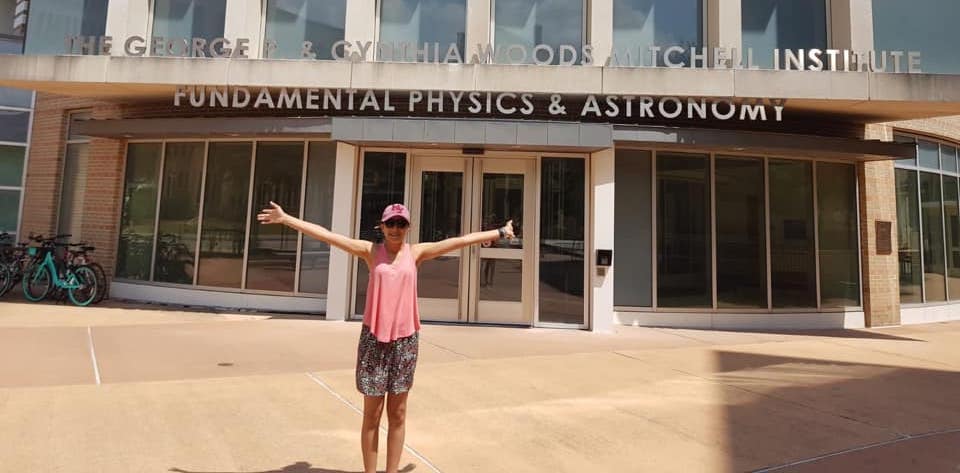

Below are some highlights of the most interesting results I have found so far during my career in Extragalactic Astronomy. Click the links below to explore them.
Space-based Slitless Spectroscopy
Understanding the Physics with toy models
Recently quenched galaxies contribute to quiescent galaxy size growth
Are recently quenched cluster galaxies faded discs?
Direct Evidence for Outside-in Quenching in the Distant Universe
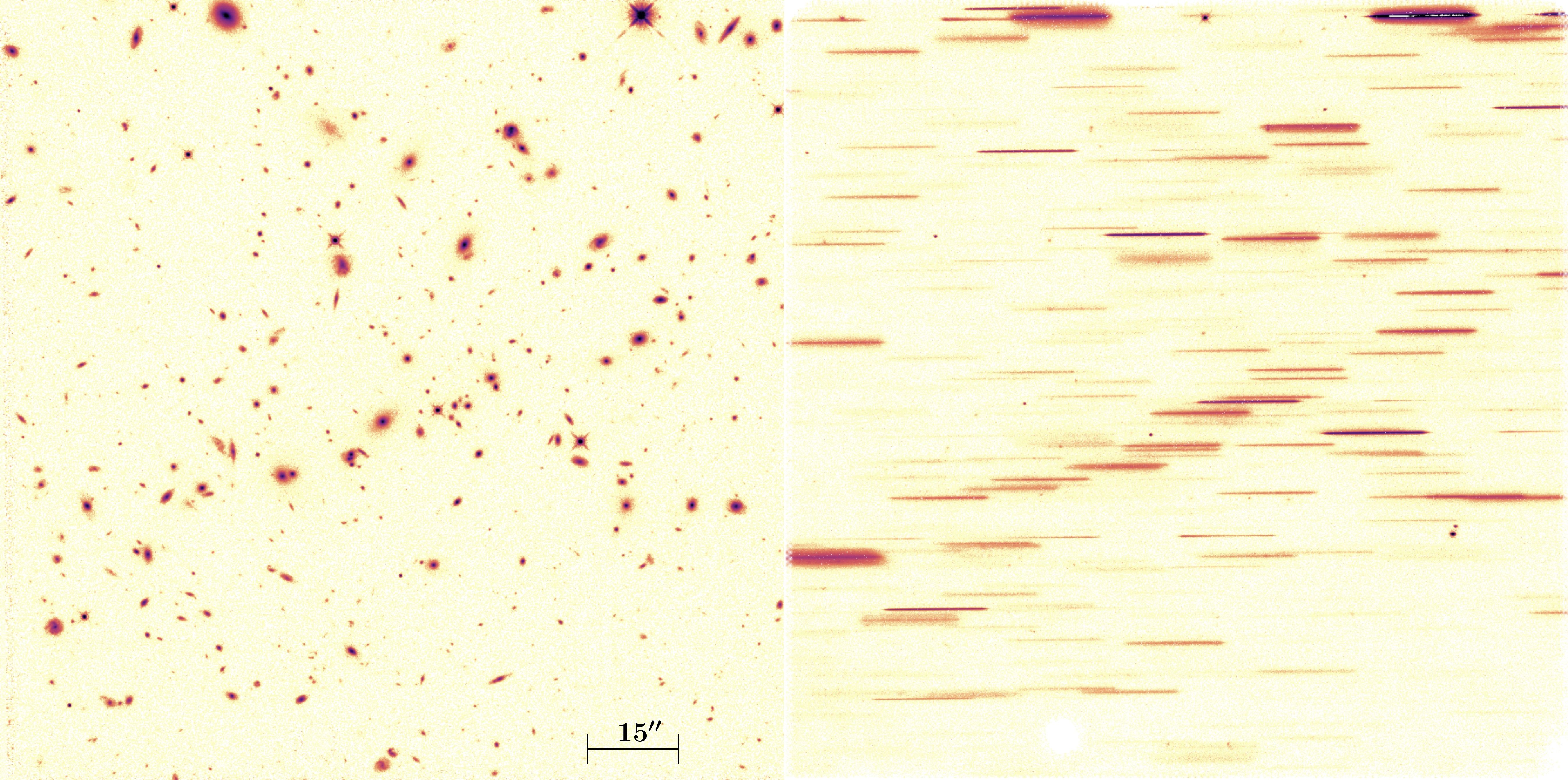
Slitless spectroscopy uses the combination of a diffraction grating and prism (a “grism”) to create an image of a galaxy at every wavelength within some range. The image on the left is an image of a Galaxy Cluster taken with the Hubble Space Telescope using a single filter. You can think of it as an image of the Galaxy Cluster at some fixed wavelength of light. The image to its right shows the grism spectra for the same Galaxy Cluster also obtained using the Hubble Space Telescope. You can see that grism spectra look like horizontal streaks. Each streak is actually images of the same galaxy at different wavelengths, very close together side-by-side with some overlap.
During my PhD, I found that when space-based grism spectroscopy is combined with a sufficiently large amount of imaging using a wide range of filters, it is almost as successful as slit spectroscopy in identifying galaxies that are members of a cluster. Usually, cluster members are identified using slit spectroscopy which can be expensive to obtain. This result is best seen by the tight clustering of green crosses (secure cluster members) in the second column compared to the first column (no grism spectroscopy) of the plot shown. Click here to find out more about this work.
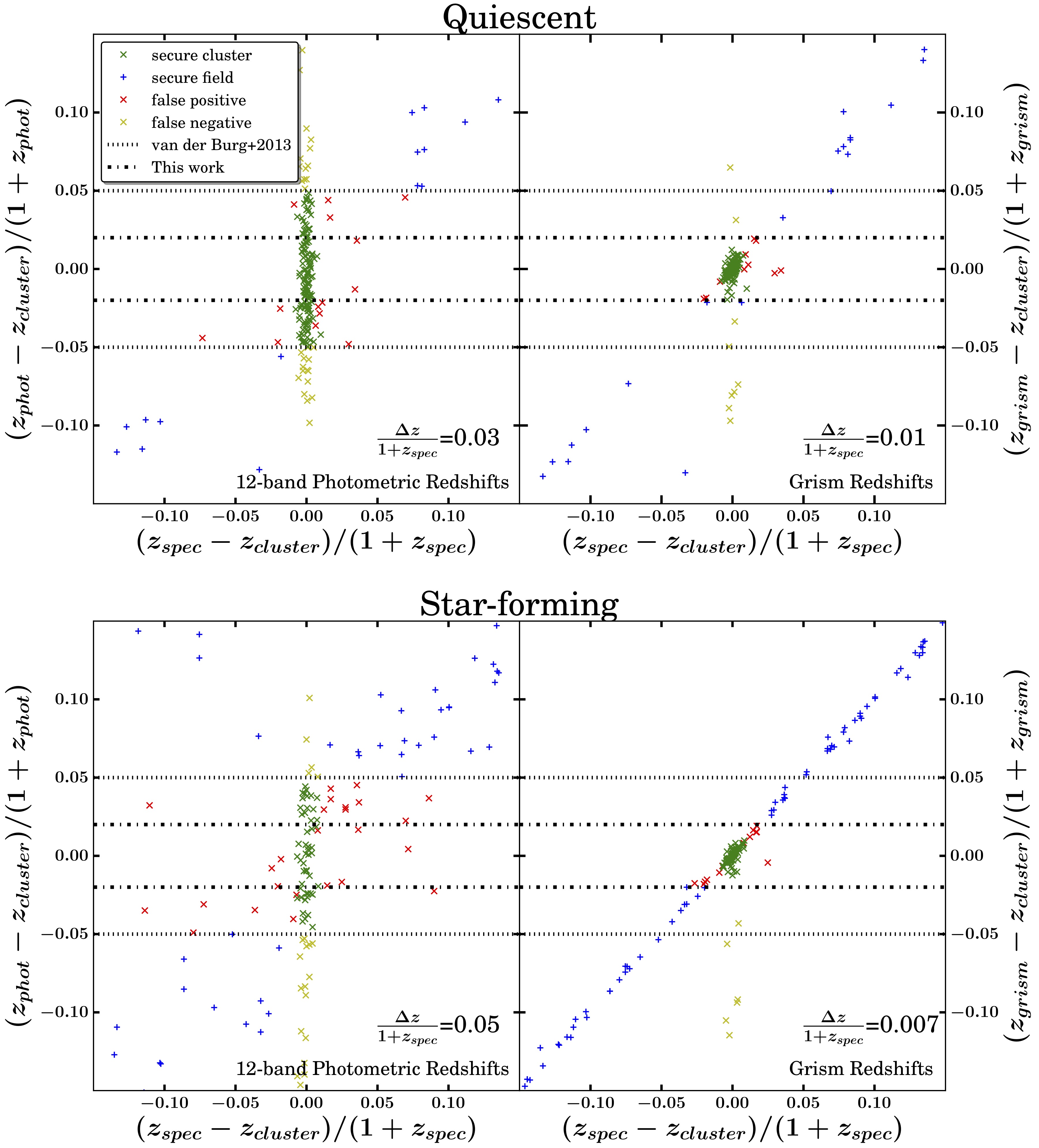
When star formation ceases in a galaxy (or is “quenched”), we refer to this galaxy as “quiescent”. Today, the Universe is 13.7 billion years old. Since it reached an age of about 3.3 billion years, the amount of star formation occurring per unit time in a given volume of the Universe has been in continuous decline. This has led to a build-up of quiescent galaxies in the Universe.
Observations have shown that quiescent galaxies grow disproportionately more in size than stellar mass as the Universe ages. Many studies have argued that minor mergers (mergers between two galaxies that have very different stellar masses) are responsible for this size growth. To test this hypothesis, it is possible to use the cluster environment as a laboratory. Cluster galaxies have high peculiar velocities, making mergers between them rare. Since minor mergers are expected to increase galaxy size more than they do stellar mass, the most direct way to test this is to measure the stellar mass–size relations in both the cluster and field (small groups of relatively isolated galaxies) environments at a fixed point in time and compare them to see if there is a significant offset in size.
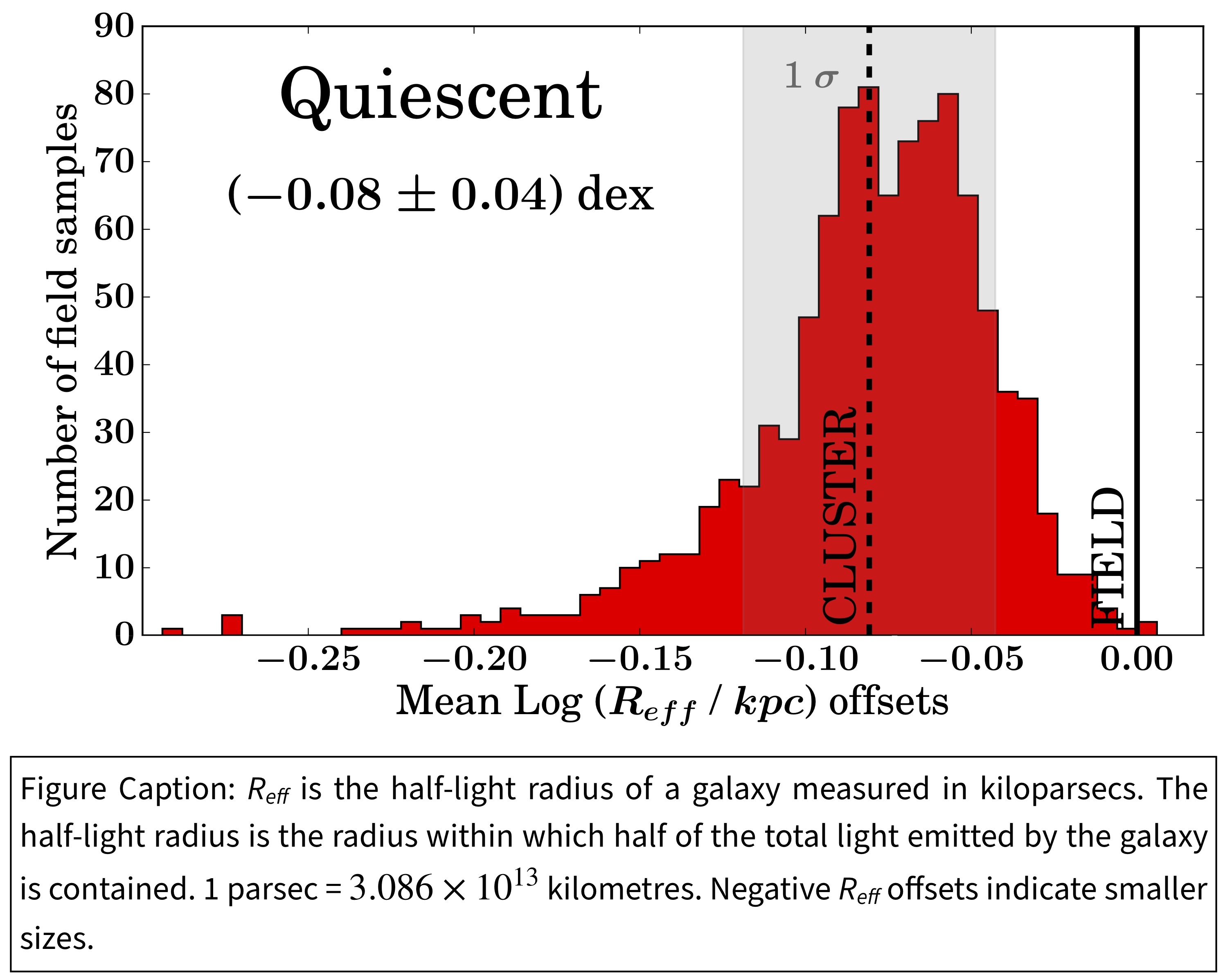
If the predictions of minor mergers driving galaxy size growth are true, cluster galaxies should find themselves inhibited from size growth and will therefore be significantly smaller than field galaxies at fixed stellar mass. In Matharu et al., (2019), we conducted this experiment using cluster and field galaxies residing at a time when the Universe was approximately 6 billion years old. The plot shows our main result: quiescent cluster galaxies are smaller than quiescent field galaxies. This result supports the case that minor mergers drive the rapid size growth we observe in quiescent field galaxies.
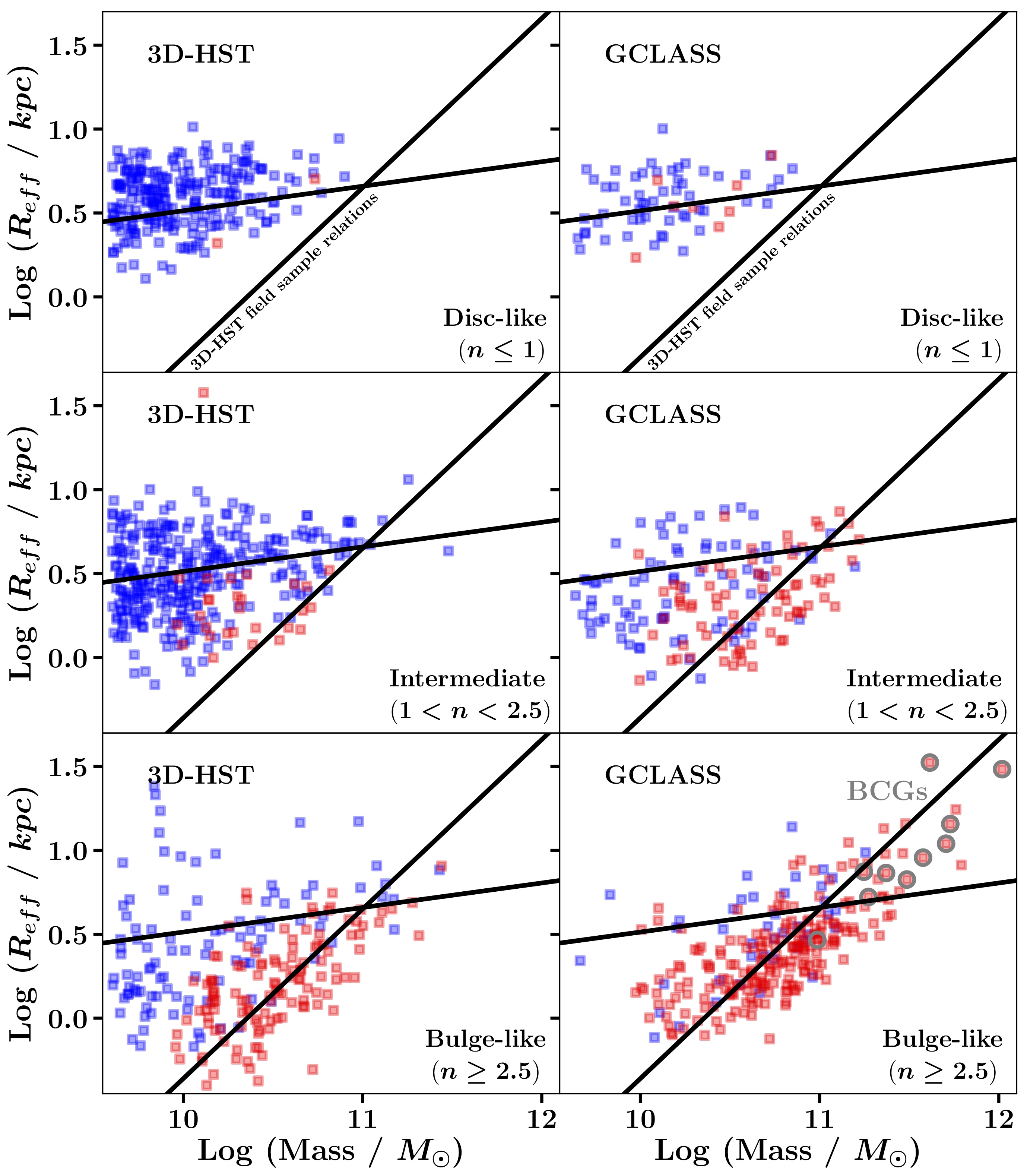
We have known for a while now that galaxies residing in clusters are redder in colour, less actively star-forming and more bulge-dominated than their counterparts in the field (small groups of galaxies). But so far, it has been difficult to pinpoint exactly why this is the case.
In Matharu et al., (2019), we tracked the morphology of both star-forming and quiescent (not star-forming) galaxies across the stellar mass—size plane, both in the field and cluster environments. In the figure shown, the first column shows the results for the field and the second column shows the results for Galaxy Clusters. This experiment was conducted with galaxies residing at a time when the Universe was approximately 6 billion years old.
The first thing to notice is that both star-forming (blue points) and quiescent (red points) galaxies broadly follow the same mass—size relations in both environments for all three types of morphology. However, there is clearly a larger fraction of quiescent intermediates and bulge-like galaxies in the clusters. This excess population of quiescent intermediates and bulge-like galaxies indicates that the cluster environment is more efficient at quenching galaxies of their star formation than the field environment.
The increased efficiency in quenching intermediate-type galaxies may be directly responsible for the larger fraction of quiescent bulge-like galaxies in clusters, because the physical process could make the galaxy end up looking more bulge-like. This result suggests there is a direct morphological consequence of environmental quenching.
As the Universe ages, quiescent (not star-forming) galaxies grow more rapidly in size than stellar mass. Observations have shown that if we compare the sizes of cluster and field quiescent galaxies in the present-day Universe, they are the same or very similar. This is different from the result we found when the Universe was approximately 6 billion years old: quiescent cluster galaxies were found to be noticeably smaller than their field counterparts.
To explain the results in the present-day Universe, cluster quiescent galaxies need to grow in size via some other route than minor mergers (since these are rare in clusters), such that they can “catch up” with their field counterparts by the present day. In Matharu et al., (2019), we presented a toy model which showed that quiescent cluster galaxies could catch up with their field counterparts due to cluster-specific physical processes.

These physical processes would need to 1) destroy ~60% of the smallest, most compact galaxies in the cluster and 2) merge the remaining ~40% of compact galaxies with the galaxy at the centre of the cluster. Combined with the infall of younger, more larger galaxies from the field into the cluster over time, these processes could help explain why we observe no difference in the quiescent mass—size relation with environment in the present day Universe. To understand more about the plot shown, click here.
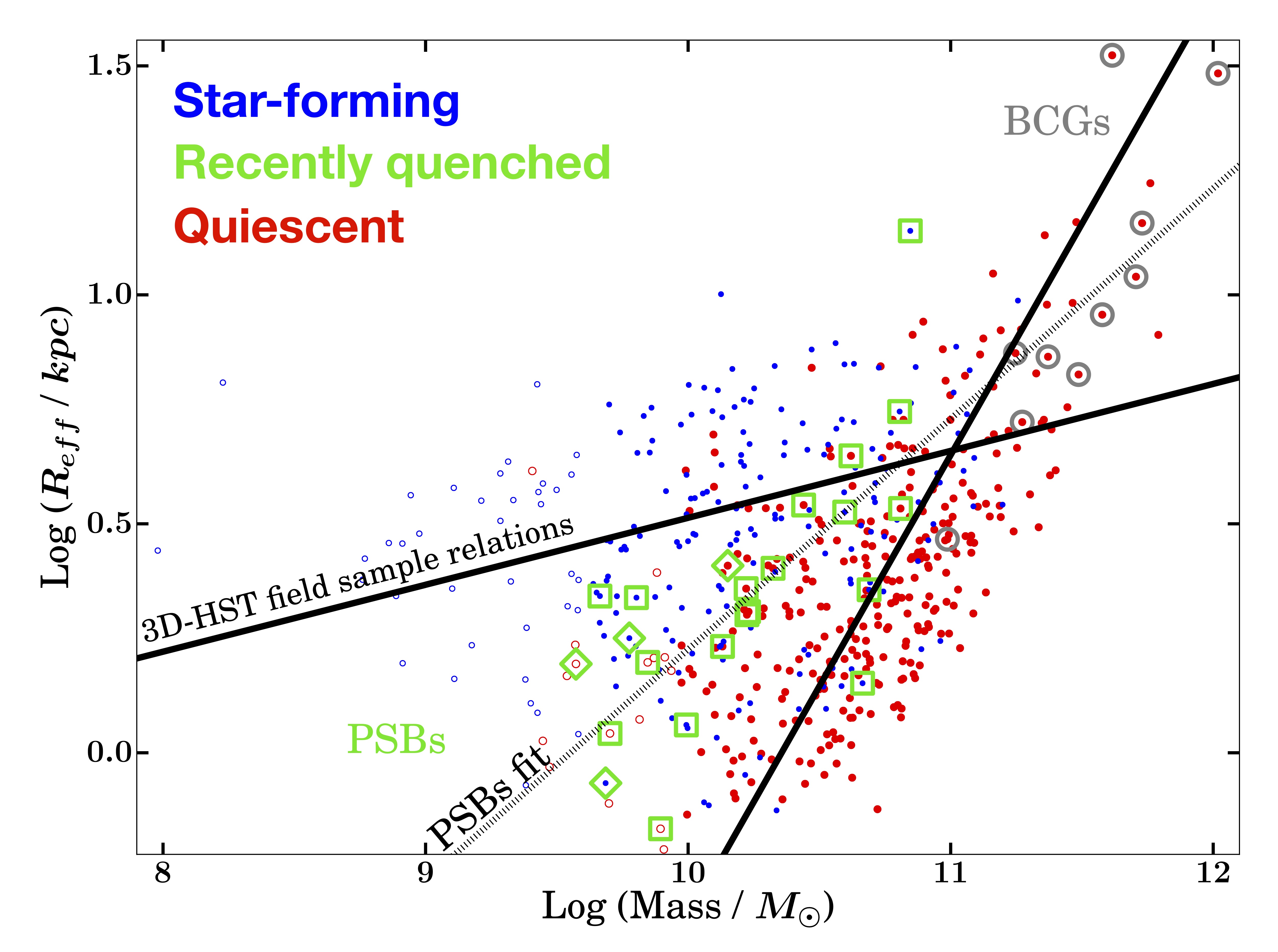
As the Universe ages, quiescent (not star-forming) galaxies grow more rapidly in size than stellar mass. The two leading explanations for this size growth are minor mergers and the addition of recently quenched galaxies to the quiescent population. Star-forming galaxies have larger sizes on average compared to quiescent galaxies. When they stop forming stars and quench, they join the quiescent population of galaxies at the large size end of the distribution. Therefore, recently quenched galaxies should have larger sizes than quiescent galaxies on average. Over time, the addition of recently quenched galaxies to the quiescent population should therefore induce an increase in the average size of quiescent galaxies.
In Matharu et al., (2020), we found direct evidence for this process by studying the position of 23 spectroscopically identified recently quenched cluster galaxies on the mass—size plane (green markers in the plot shown).
Recently quenched cluster galaxies follow a mass—size relation lying midway between the star-forming and quiescent field mass—size relations (dotted line in the plot). This result confirmed that the average size of quiescent galaxies does increase due to the quenching of star-forming galaxies as well as minor mergers.
What is the physical process that causes the formation of recently quenched galaxies in clusters? Given the results we found about recently quenched cluster galaxies on the mass—size plane, we tried to see if disc-fading could explain the mass—size relation of recently quenched cluster galaxies. We created model galaxies (plot shown) composed of a disc and bulge, then faded the disc “outside-in” to replicate the way quenching proceeds in clusters.
In Matharu et al., (2020), we found that “outside-in” fading has the potential to cause the reduction in size and increase in bulge-dominance observed between star-forming and recently quenched cluster galaxies. However, more sophisticated modeling will be required to fully reproduce the structural properties of the observed recently quenched cluster galaxies.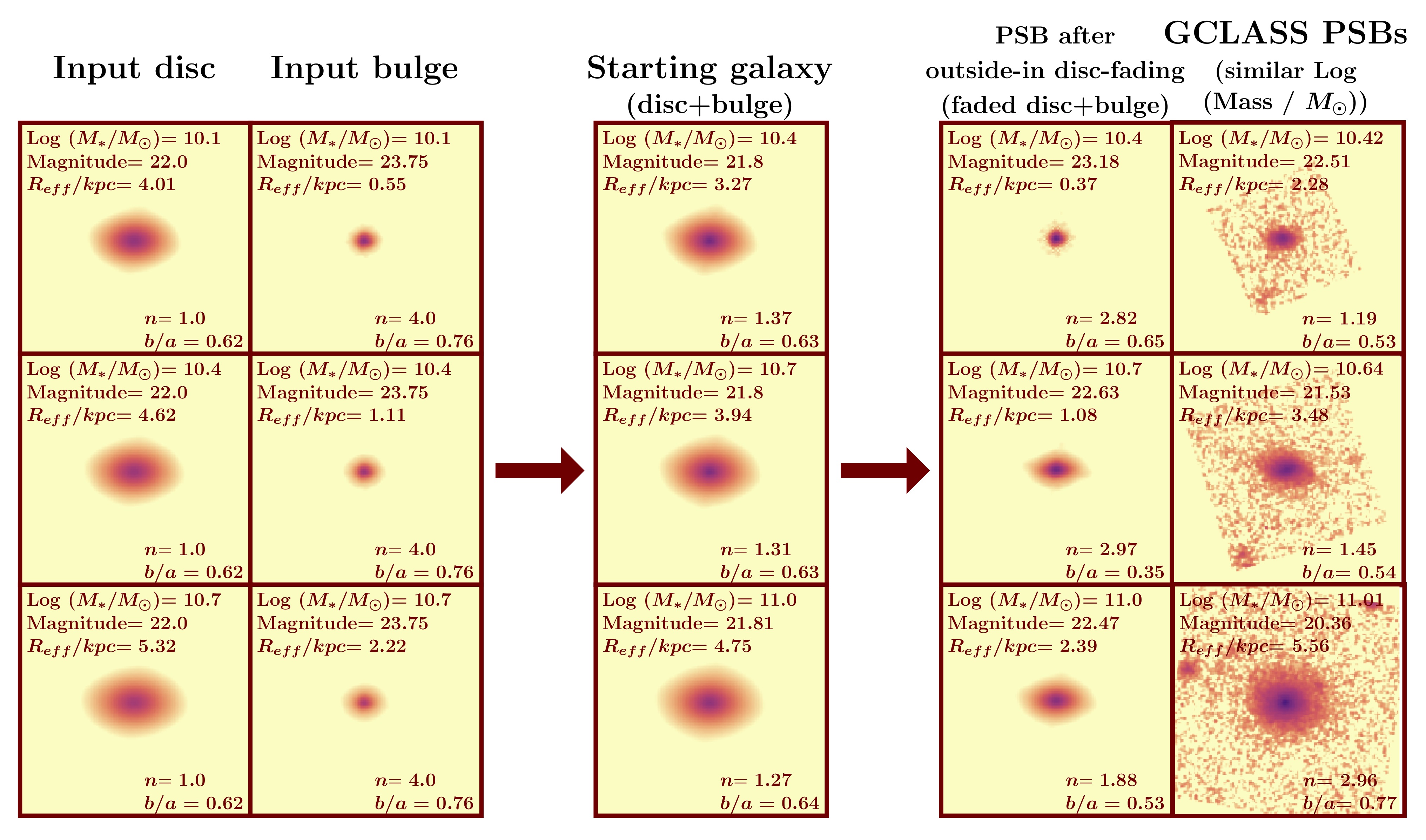
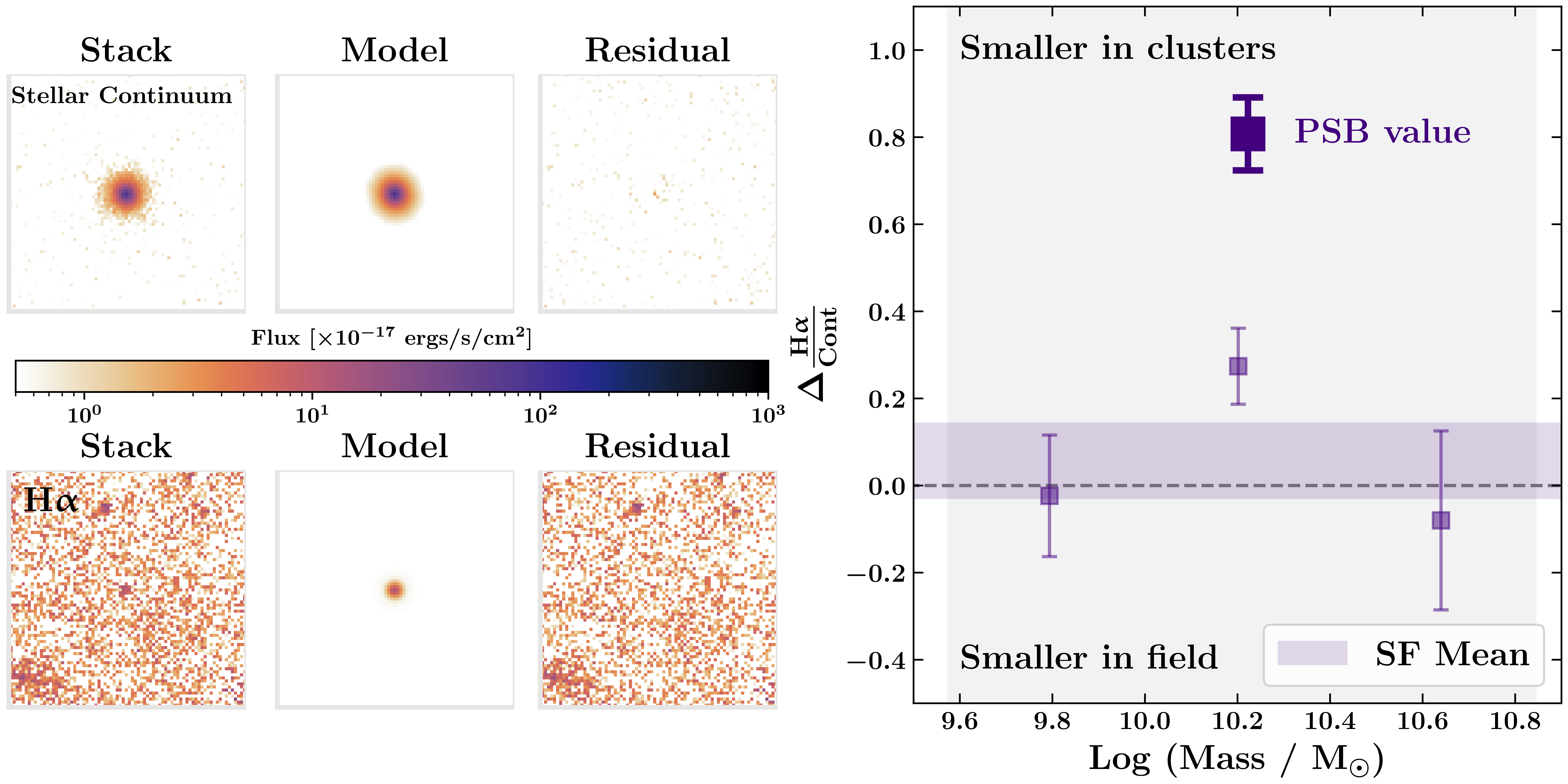
Galaxies that reside in nearby Galaxy Clusters are observed to shut down their star formation via the process of ram-pressure stripping, an animation for which is shown below. Other work in the literature has suggested ram-pressure stripping may also be happening in distant Galaxy Clusters, but much faster, more efficiently or not very often.
In Matharu et al., (2021), we made the first direct detection of outside-in quenching due to ram-pressure stripping in distant Galaxy Clusters by measuring a much smaller gaseous disk compared to the starlight disk in recently quenched cluster galaxies.
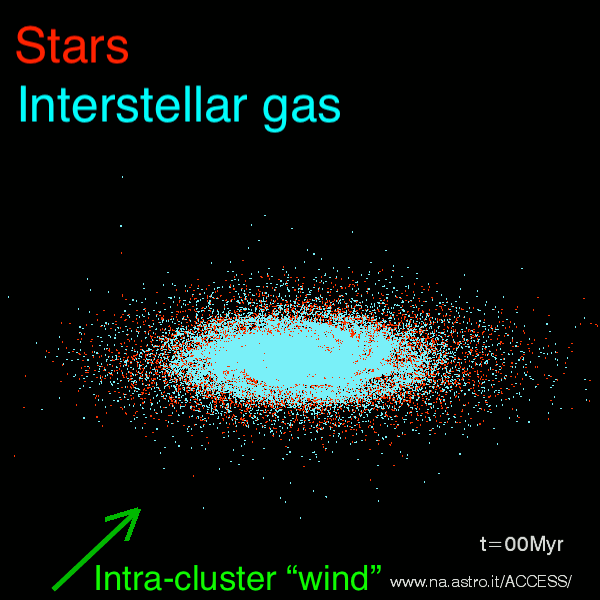
Publications
(Last updated 19th April 2024)
Refereed publications: 36, first author: 5, total citations: 1100, H-index: 17
First author publications
- Matharu, J., Muzzin, A., Sarrouh, G.T.E., Brammer, G., Abraham, R., Asada, Y., Brada{\v c}, M., Desprez, G., Martis, N., Mowla, L., Noirot, G., Sawicki, M., Strait, V., Willott, C.J., Gould, K.M.L., Grindlay, T. and Harshan A.T. 2023, "A First Look at Spatially Resolved Balmer Decrements at 1.0 < z < 2.4 from JWST NIRISS Slitless Spectroscopy". The Astrophysical Journal Letters, Volume 949, Issue 1, id.L11.
- Matharu, J., Papovich, C., Momcheva, I., Simons, R.C., Brammer, G.B., Ji, Z., Backhaus, B.E., Cleri, N. J., Estrada-Carpenter., V., Finklestein, S.L., Finlator, K., Giavalisco, M., Jung, I., Muzzin, A., Pillepich, A., Trump, J.R., Weiner, B. 2022, "CLEAR: The Evolution of Spatially Resolved Star Formation in Galaxies between 0.5 < z < 1.7 using H-Alpha Emission Line Maps". The Astrophysical Journal, Volume 937, Issue 1, id.16.
- Matharu, J., Muzzin, A., Brammer, G.B., Nelson, E.J., Auger, M.W., Hewett, P.C., van der Burg, R., Balogh, M., Demarco, R., Marchesini, D., Noble, A.G., Rudnick, G., van der Wel, A., Wilson, G. and Yee, H.K.C. 2021, "HST/WFC3 Grism Observations of z ∼ 1 Clusters: Evidence for Rapid Outside-in Environmental Quenching from Spatially Resolved H-Alpha Maps". The Astrophysical Journal, Volume 923, Issue 2, id.222. Click here for public data release
- Matharu, J., Muzzin, A., Brammer, G.B., van der Burg, R.F.J., Auger, M.W., Hewett, P.C., van der Wel, A., van Dokkum, P., Chan, J.C.C., Demarco, R., Marchesini, D., Nelson, E.J., Noble, A.G. and Wilson, G. 2020, "HST/WFC3 grism observations of z ∼ 1 clusters: evidence for evolution in the mass–size relation of quiescent galaxies from poststarburst galaxies". Monthly Notices of the Royal Astronomical Society, Volume 493, Issue 4, Pages 6011–6032.
- Matharu, J., Muzzin, A., Brammer, G.B., van der Burg, R.F.J., Auger, M.W., Hewett, P.C., van der Wel, A., van Dokkum, P., Balogh, M., Chan, J.C.C., Demarco, R., Marchesini, D., Nelson, E.J., Noble, A.G., Wilson, G. and Yee, H.K.C. 2019, "HST/WFC3 grism observations of z ∼ 1 clusters: The cluster versus field stellar mass–size relation and evidence for size growth of quiescent galaxies from minor mergers". Monthly Notices of the Royal Astronomical Society, Volume 484, Issue 1, Pages 595–617.
A record of my peer reviews since 2021 can be found on Publons.
Grizli for Dummies
Grizli for Dummies is an unofficial guide to using the Grism redshift & line analysis software (Grizli). It is now part of the official Grizli documentation and can be found here. Grizli for Dummies is open source — which means if you would like to contribute, you can! Just fork the Grizli repository, read the instructions at the top of the Grizli for Dummies document on how to contribute to it, make your contributions and submit a pull request. I will review and approve your contributions.
